![]()
![]()
![]()
Use LEFT and RIGHT arrow keys to navigate between flashcards;
Use UP and DOWN arrow keys to flip the card;
H to show hint;
A reads text to speech;
191 Cards in this Set
- Front
- Back
- 3rd side (hint)
|
Organic Molecules |
Has a minimum of carbon and hydrogen |
|
|
|
Organic Molecules |
Very greatly and size and structure due to carbon’s ability to form up to for single covalent bonds |
|
|
|
Carbon skeleton |
The core of an organic compound : usually a series of carbon atoms bonded to each other and bonded to hydrogen’s on the side |
|
|
|
Functional groups |
A small group of atoms sticking out of a large organic molecules |
|
|
|
Functional groups tend to be polar or ionic ... |
And therefore react with other molecules they give the organic molecule thay Part of most of its properties |
|
|
|
Macromolecule |
A big organic molecule |
|
|
|
Polymer |
Made of repeated subunits (like a train) at least five repeated |
|
|
|
Monomer |
The subunit (or a building block of a polymer) Monomers are medium size molecules |
|
|
|
Triglycerides are fats or oils |
One glycerol and three fatty acid’s |
|
|
|
Ribosomes make? |
Protein |
|
|
|
Dehydration synthesis : Building polymers from monomers |
In order to add a monomer to a polymer one H2O must be ejected dehydration means to lose water synthesis means to build or assemble |
|
|
|
Hydrolysis :Breaking down polymers into monomers |
In order to break off a monomer from a polymer one H2O must be inserted Hydro meaning water lyses means break or bust |
|
|
|
Isomers to Atoms put together in different ways (Iso meaning equal) |
Molecules with the same molecular formula but different structures in there for different properties |
|
|
|
Carbohydrates |
In organic molecule made of carbon hydrogen and oxygen in a 1:2:1 ratio |
|
|
|
General formula for all |
N(CH2O) |
|
|
|
Types of carbohydrates |
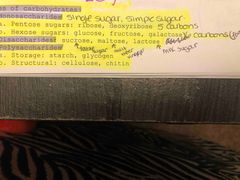
Types of carbohydrates |
|
|
|
Monosaccharides |
These are monomers of all other carbohydrates they contain 3 to 6 carbons Functions Pinto sugars are parts of the monomers of RNA and DNA hexose sugars are the monomers of disaccharides and polysaccharides they also supply quick energy |
|
|
|
Importance of glucose |
All energy foods must be converted to glucose before their energy is released released examples sugar starch fats oils and proteins |
|
|
|
Disaccharide |
Two monosaccharides joined by dehydration synthesis the function is a quick burst of energy |
|
|
|
Polysaccharides |
Five or more monosaccharides |
|
|
|
Storage polysaccharides |
Function what is stored energy takes a long time to break down all the bonds |
|
|
|
Glycogen |
Made by animals stored in liver and muscles structure highly branched version of starch |
|
|
|
Relationship between glycogen and Glucose |
If blood glucose levels are too high it’s called hyperglycemia if blood glucose levels are too low it’s called hypoglycemia Insulin Paul’s extra sugar and regulate it in stores it in the liver and muscles |
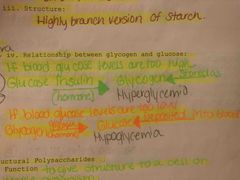
|
|
|
Structural polysaccharides |
Function is to give structure to a cell or a whole organism |
|
|
|
Starch |
Made by plants found in cell walls Structure chain of about 200 glucose units note: starch comes in two forms on branch amylose and branch amylopectin |
|
|
|
the difference between starch and cellulose |
Starch and cellulose are two very similar polymers. In fact, they are both made from the same monomer, glucose, and have the same glucose-based repeat units. There is only one difference. In starch, all the glucose repeat units are oriented in the same direction |
|
|
|
Fiber |
is found in Metamucil and fruits and vegetables it cleans out the colon and prevents colon cancer It regulates bowel movements unhealthy diarrhea acts like a sponge and absorb the water for constipation it draws water and two: by osmosis structure straight chain of many glucose unit cellulose on the top starch on the |
|
|
|
Fiber cellulose on the top starch on the Bottom |
is found in meta-Meusel fruits and vegetables it cleans out the colon and prevent colon cancer It regulates bowel movements unhealthy diarrhea acts like a sponge and absorb the water for constipation it draws water and two: by osmosis structure straight chain of many glucose unit |
|
|
|
Why is Cellulose indigestible to humans? |
To Digest cellulose an enzyme has to fit over pairs of glucose units to break their bonds cents each glucose is upside down compared to its neighbors did that enzyme simply doesn’t fit |
|
|
|
Chitin |
Found in the exoskeletons and found in the cell walls of fungi they contain carbon hydrogen oxygen and nitrogen |
Arthropods have a jointed appendages like insects crustaceans crabs shrimp horse shoe crab and spiders Exoskeletons which is the shell or outer layer of arthropods
|
|
|
LIPIDS |
Contains carbon and hydrogen in a 1 to 2 ratio and contains very little oxygen all lipids are hydrophobic which does not dissolve in water it repels water because the lack of oxygen |
|
|
|
Note about lipids: |
Lipids are hydrophobic and sellable and non polar solvents because they have so few oxygen atoms oxygen is highly electronegative and makes molecules polar |
Examples are fat oil wax chlorophyll hormone steroids human growth steroids estrogen human growth hormones cholesterol vitamins A D E K and testosterone |
|
|
Neutral fats |
They all yelled more than twice the energy program as do carbohydrates neutral fat have one guys are all +12 or three fatty acids mono die and triglyceride |
|
|
|
Structure of triglycerides |
One glycerol (polymer) and three fatty acid’s (monomer) |
|
|
|
Double bond |
Two electrons being shared |
|
|
|
Saturated filled with hydrogen? |
Saturated fats yes unsaturated fats no |
|
|
|
Are there double bonds between carbon’s C = C in fatty acids |
Saturated fats no unsaturated fat yes |
|
|
|
Are there Bends in fatty acids? |
Saturated fats no unsaturated fat yes |
|
|
|
Can too many molecules be packed together densely? |
Saturated fats yes all fatty acids or straight parallel unsaturated fats no fatty acids are fluffy |
|
|
|
Is it solid or liquid at room temperature |
Saturated fats solid fats unsaturated fat’s liquid oil |
|
|
|
Can it lead to atherosclerosis (deposit into blood vessels) |
Saturated fats yes Unsaturated fat’s less so |
|
|
|
Saturated Fats VS UNSATURATED FATS |
Unsaturated fat fluffy a symmetrical and packed together Why are saturated fats more dangerous saturated with hydrogen where the gap come from double bond between Carbons |
|
|
|
Functions of fats |
Stores energy insulates against heat loss acts as a cushion around organs to prevent physical injury |
Eyeballs and ovaries are examples |
|
|
Chemical structure of proteins (monomers) |
Made of and supply carbon hydrogen oxygen and nitrogen and sometimes sulfur one of 20 has sulfur supplies energy causes movement (alot per cell) and cytoplasmic (muscles Cilia Flagella ) Select what enters and leaves a cell all enzymes which speed up reactions are made of proteins scabs are External blood clots that are made of proteins some hormones are proteins chemical messengers acts as an on off switch is for genes in DNA |
Cilia throat fallopian tubes Flagella sperm tails |
|
|
Chemical structure of proteins |
Monomers are amino acids |
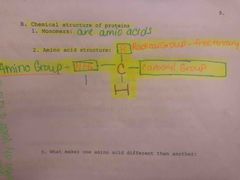
Amino acid structure |
|
|
How many types of amino acids are there? |
20 in animal kingdom |
|
|
|
Peptide Bond |
Is the bond that forms between two amino acids |
|
|
|
1 g of fat only-yeilds |
8 kilo calories |
|
|
|
1 Gram of Protein only yeilds |
Four kilo calories |
|
|
|
The difference between a Protein and a polypeptide |
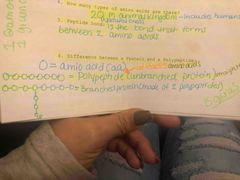
Back (Definition) |
|
|
|
Primary Structure |
1° structure a list of which amino acids Are in a poly peptide and in what order |
|
|
|
Secondary structure (shape) |
2° structure either in accordion like folding (pleated sheet) or a spiral shape (alpha helix) held together by week hydrogen bonds between neighboring amino acids |
|
|
|
Tertiary structure |
3° structure twisting and turning of a polypeptide around in through its self caused by various bonds often between distant amino acids |
|
|
|
Quaternary structure |
4 degree structure just like tertiary but this refers to a branched protein |
|
|
|
Denaturing proteins |
Changing the shape by breaking it’s weaker bonds but not its chemical composition causes extreme heat 75°C changing the PH environment changing the salinity saltiness |
Like frying an egg clear to white |
|
|
Nucleic acid’s |
They are RNA and DNA |
|
|
|
Functions of DNA |
Contains the genetic code which is a blueprint for how your body develops from conception to adulthood and maintain your genetic traits once they develop Jeans on DNA respond to incoming information by telling the cell to make or stop making enzymes on a moment by moment basis therefore genes control everything about your metabolism via enzymes DNA is the only noon molecule that can copy it self so when cells make new cells DNA is passed on When cells produce gametes (sperm is in eggs) and they fertilize each other the genetic code is passed on to the next generation (heredity) |
|
|
|
Functions of RNA |
Messenger RNA (mRNA) Copies the code from a single gene (transcription) and brings it out of the cells nucleus to ribosomes in the cytoplasm Ribosomal RNA (rRNA) Ribosomes the organelles that put together amino acids to make a polypeptide are made of this Transfer RNA (tRNA) Each tRNA is designed to pick up a specific amino acid from the cytoplasm and bring it back to the ribosome as per instructions on the mRNA as it threads its way through the ribosome |
|
|
|
The difference between a Protein and a polypeptide |

Back (Definition) |
|
|
|
The difference between a Protein and a polypeptide |
Back (Definition) |
|
|
|
Monomers of nucleic acid’s |
Gluciotides |
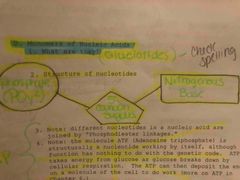
Structure |
|
|
The difference between a Protein and a polypeptide |
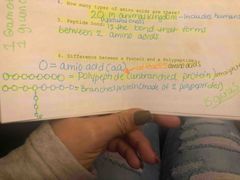
Back (Definition) |
|
|
|
Over all shape of RNA and DNA |
RNA alpha helix (single spiral of nucleotides) DNA double helix (2parallel spiral of nucleotides joined in the middle by pairs of nitrogen bases) |
|
|
|
Five carbon sugar RNA and DNA |
RNA - ribose DNA - deoxyribose |
|
|
|
Nitrogenous base of RNA and DNAAll those cute girls |
RNA - adenine (A), uracil (U), cytosine (C), guanine (G) DNA adenine (A), Thymine (T), Cytosine (C), Guanine (G) |
|
|
|
All those cute girls |
Adenine pairs with thymine and cytosine with Guanine |
|
|
|
Gene |
The part of the DNA molecule which codes for one polypeptide (unbranched protein) Note : Genes are the functional subunits of DNA nucleotides are the structural subunits of DNA |
|
|
|
What is the genetic code |
Looking at one side of the DNA molecule three successive nitrogen us bases on three nucleotides code for one amino acid |
# of nucleotides and * that by 3 to get how many nitrogenous bases |
|
|
General structure of a cell |
Surrounded by a plasma (cell) membrane cytoplasm everything inside plasma membrane cytosol equals H2O plus various ions/molecules dissolve or suspend a 92% H2O Organelles Cytoskeleton network of protein fibers used for support and movement |
|
|
|
Monomers of nucleic acid’s |
Gluciotides |
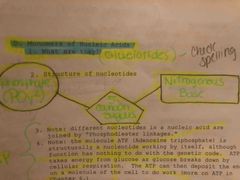
Structure |
|
|
Surface area and volume explanation |
1 Surface. Volume side area(l•w). (l•w•h) 1 M. 6 M^2 1 M^3 10 M. 600 M^2. 1000M^3 Difference. Increases. Increases 10 x. 100X. 1000X |
Note: volume increases much faster than surface area |
|
|
Explanation in words of surface area |
As a cell gets bigger it’s volume represented by number of organelles increases much faster than its surface area plasma membrane at some point the membrane can no longer supply all the organelles nutrients gases and waste removal so the cell dies |
|
|
|
Cell theory |
Scheldon and Schwann(1930s) 1. All living things are made of cells 2. Cells are the building blocks of life: all characteristics of life occur at the cellular level Virchow (1880s) Spontaneous generation the idea that life can arise from nonliving matter is false life comes from life/cells from other cells |
|
|
|
For kilo calories |
For kilo calories |
|
|
|
The difference between a Protein and a polypeptide |
Back (Definition) |
|
|
|
1° structure a list of which amino acids Are in a poly peptide and in what order |
1° structure a list of which amino acids Are in a poly peptide and in what order |
|
|
|
Secondary structure (shape) |
2° structure either in accordion like folding (pleated sheet) or a spiral shape (alpha helix) held together by week hydrogen bonds between neighboring amino acids |
|
|
|
Tertiary structure |
3° structure twisting and turning of a polypeptide around in through its self caused by various bonds often between distant amino acids |
|
|
|
Quaternary structureDenaturing proteins |
For degree structure just like tertiary but this refers to a branched protein |
|
|
|
Denaturing proteins |
Changing the shape by breaking it’s weaker bonds but not its chemical composition causes extreme heat 75°C changing the PH environment changing the salinity saltiness |
Like frying an egg clear to white |
|
|
Nucleic acid’s |
They are RNA and DNA |
|
|
|
Is the bond that forms between two amino acids |
Is the bond that forms between two amino acids |
|
|
|
1 g of fat only-yields: |
8 kilo calories |
|
|
|
1 g of protein equals |
4 kilo calories |
|
|
|
The difference between a Protein and a polypeptide |

Back (Definition) |
|
|
|
Primary structure |
1° structure a list of which amino acids Are in a poly peptide and in what order |
|
|
|
Secondary structure (shape) |
2° structure either in accordion like folding (pleated sheet) or a spiral shape (alpha helix) held together by week hydrogen bonds between neighboring amino acids |
|
|
|
Tertiary structure |
3° structure twisting and turning of a polypeptide around in through its self caused by various bonds often between distant amino acids |
|
|
|
Quaternary structure Denaturing proteins |
For degree structure just like tertiary but this refers to a branched protein |
|
|
|
Denaturing proteins |
Changing the shape by breaking it’s weaker bonds but not its chemical composition causes extreme heat 75°C changing the PH environment changing the salinity saltiness |
Like frying an egg clear to white |
|
|
Nucleic acid’s |
They are RNA and DNA |
|
|
|
Functions of DNA |
Contains the genetic code which is a blueprint for how your body develops from conception to adulthood and maintain your genetic traits once they develop Jeans on DNA respond to incoming information by telling the cell to make or stop making enzymes on a moment by moment basis therefore genes control everything about your metabolism via enzymes DNA is the only noon molecule that can copy it self so when cells make new cells DNA is passed on When cells produce gametes (sperm is in eggs) and they fertilize each other the genetic code is passed on to the next generation (heredity) |
|
|
|
Functions of RNA |
Messenger RNA (mRNA) Copies the code from a single gene (transcription) and brings it out of the cells nucleus to ribosomes in the cytoplasm Ribosomal RNA (rRNA) Ribosomes the organelles that put together amino acids to make a polypeptide are made of this Transfer RNA (tRNA) Each tRNA is designed to pick up a specific amino acid from the cytoplasm and bring it back to the ribosome as per instructions on the mRNA as it threads its way through the ribosome |
|
|
|
Monomers of nucleic acid’s |
Gluciotides |

Structure |
|
|
Shape of RNA and DNA |
RNA alpha helix (single spiral of nucleotides) DNA double helix (2parallel spiral of nucleotides joined in the middle by pairs of nitrogen bases) |
|
|
|
5 carbon sugars Of RNA and DNA |
RNA - ribose DNA - deoxyribose |
|
|
|
Nitrogenous bases of RNA and DNA |
RNA - adenine (A), uracil (U), cytosine (C), guanine (G) DNA adenine (A), Thymine (T), Cytosine (C), Guanine (G) |
|
|
|
All those cute girls |
Adenine pairs with thymine and cytosine with Guanine |
|
|
|
Genes |
The part of the DNA molecule which codes for one polypeptide (unbranched protein) Note : Genes are the functional subunits of DNA nucleotides are the structural subunits of DNA |
|
|
|
What is the genetic code ? |
Looking at one side of the DNA molecule three successive nitrogen us bases on three nucleotides code for one amino acid |
# of nucleotides and * that by 3 to get how many nitrogenous bases |
|
|
General structure of a cell |
Surrounded by a plasma (cell) membrane cytoplasm everything inside plasma membrane cytosol equals H2O plus various ions/molecules dissolve or suspend a 92% H2O Organelles Cytoskeleton network of protein fibers used for support and movement |
|
|
|
Why are cells so small nucleus/cytoplasm explanation 5-20 Micrometers |
1. Molecules are received on the plasma membrane and diffuse across the cell into the nucleus and turn on a gene 2. mRNA Must diffuse out of the nucleus and tell a ribosome which protein make diffusion across the cytosol is slow so if a cell were too big you couldn’t give a timely response to a stimulus |
|
|
|
Surface area & volume explanation |
1 Surface. Volume side area(l•w). (l•w•h) 1 M. 6 M^2 1 M^3 10 M. 600 M^2. 1000M^3 Difference. Increases. Increases 10 x. 100X. 1000X |
Note: volume increases much faster than surface area |
|
|
surface area Explanation in words |
As a cell gets bigger it’s volume represented by number of organelles increases much faster than its surface area plasma membrane at some point the membrane can no longer supply all the organelles nutrients gases and waste removal so the cell dies |
|
|
|
Cell theory |
Scheldon and Schwann(1930s) 1. All living things are made of cells 2. Cells are the building blocks of life: all characteristics of life occur at the cellular level Virchow (1880s) Spontaneous generation the idea that life can arise from nonliving matter is false life comes from life/cells from other cells |
|
|
|
Prokaryotic Cells |
Only possessed by Bacteria (Kingdom Monera) Cytoskeleton is absent Cell membrane has numerous infoldings specialized for complex chemical reactions appear to be evolving into organelles DNA not contained in a nucleus “naked” DNA not wrapped around proteins so it’s not called a Chromosome DNA forms a circle Organelles no membrane bound organelles but they do have ribosomes |
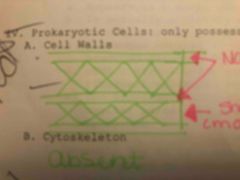
~ First and second arrow points to non cellulose Polysaccharide ~ Third arrow points to short chains of amino acids which makes cell wall dense |
|
|
Eukaryotic cells |
These have membrane bound organelles human Earliest fossils were found 1.5 billion years ago examples algae And protozoa Everything that’s not bacteria has eukaryotic cells |
|
|
|
What difference between Cilia and flagella |
There are thousands of cilia per cell and one or two flagella Per cell a 9+2 arrangement |
|
|
|
Why are cells so small |
Diffusion volume increases the faster than surface volume surface outer plasma membrane |
|
|
|
Cytoskeleton |
Works like spokes on a bicycle wheel Spindle fibers Microfilament is the thinnest kind has a sliding action contracts relax creates current Microtubules are used for separating chromosomes during cell division |
|
|
|
Endoplasmic reticulum and ribosomes |
The endoplasmic reticulum is a network of channels extending from nuclear pores to throughout the cytoplasm functions as a highway to transport materials through a cell |
|
|
|
Rough ER |
Is Dotted with tiny ribosomes giving it rough Since ribosomes are the site of protein synthesis the rough ER specializes in making and transporting proteins |
|
|
|
Smooth ER |
Produces and transports lipids and complex carbohydrates Smooth ER gets rid of excess cholesterol and detoxifies poisons by making them soluble in water so they can be excreted in the urine |
|
|
|
Cytoskeleton |
Works like spokes on a bicycle wheel Spindle fibers Microfilament is the thinnest kind has a sliding action contracts relax creates current Microtubules are used for separating chromosomes during cell division |
|
|
|
Endoplasmic reticulum and ribosomes |
The endoplasmic reticulum is a network of channels extending from nuclear pores to throughout the cytoplasm functions as a highway to transport materials through a cell |
|
|
|
Rough ER |
Is Dotted with tiny ribosomes giving it rough Since ribosomes are the site of protein synthesis the rough ER specializes in making and transporting proteins |
|
|
|
Smooth ER |
Produces and transports lipids and complex carbohydrates Smooth ER gets rid of excess cholesterol and detoxifies poisons by making them soluble in water so they can be excreted in the urine |
|
|
|
Golgi complex |
Structure stack of flatten C shaped pancakes (cysternae) which receive transport vesicles and send out secretory vesicles Receives crude products from rough and smooth ER by transport vesicles Thins off secretory vesicles for secretion from the plasma membrane Via exocytosis |
|
|
|
Cytoskeleton |
Works like spokes on a bicycle wheel Spindle fibers Microfilament is the thinnest kind has a sliding action contracts relax creates current Microtubules are used for separating chromosomes during cell division |
|
|
|
Endoplasmic reticulum and ribosomes |
The endoplasmic reticulum is a network of channels extending from nuclear pores to throughout the cytoplasm functions as a highway to transport materials through a cell |
|
|
|
Rough ER |
Is Dotted with tiny ribosomes giving it rough Since ribosomes are the site of protein synthesis the rough ER specializes in making and transporting proteins |
|
|
|
Smooth ER |
Produces and transports lipids and complex carbohydrates Smooth ER gets rid of excess cholesterol and detoxifies poisons by making them soluble in water so they can be excreted in the urine |
|
|
|
Golgi complex |
Structure stack of flatten C shaped pancakes (cysternae) which receive transport vesicles and send out secretory vesicles Receives crude products from rough and smooth ER by transport vesicles Thins off secretory vesicles for secretion from the plasma membrane Via exocytosis |
|
|
|
Golgi complex * question |
Combines crude products into many refined products refining putting together two or more complex |
|
|
|
Lysosomes |
Or sacs filled with digestive enzymes In some white blood cells lysosomes join with food vacuoles formed by Phagocytosis to digest bacteria or cancer cells (solid) Autophagy digestion and recycling of old cell parts (eat yourself) autolysis digestion of wholesale when it ages and all of its membrane’s including those of lysosomes began to fall apart (Blow self up) programmed cell death a Apoptosis |
|
|
|
Cytoskeleton |
Works like spokes on a bicycle wheel Spindle fibers Microfilament is the thinnest kind has a sliding action contracts relax creates current Microtubules are used for separating chromosomes during cell division |
|
|
|
Endoplasmic reticulum and ribosomes |
The endoplasmic reticulum is a network of channels extending from nuclear pores to throughout the cytoplasm functions as a highway to transport materials through a cell |
|
|
|
Rough ER |
Is Dotted with tiny ribosomes giving it rough Since ribosomes are the site of protein synthesis the rough ER specializes in making and transporting proteins |
|
|
|
Smooth ER |
Produces and transports lipids and complex carbohydrates Smooth ER gets rid of excess cholesterol and detoxifies poisons by making them soluble in water so they can be excreted in the urine |
|
|
|
Golgi complex |
Structure stack of flatten C shaped pancakes (cysternae) which receive transport vesicles and send out secretory vesicles Receives crude products from rough and smooth ER by transport vesicles Thins off secretory vesicles for secretion from the plasma membrane Via exocytosis |
|
|
|
Golgi complex * question |
Combines crude products into many refined products refining putting together two or more complex |
|
|
|
Lysosomes |
Or sacs filled with digestive enzymes In some white blood cells lysosomes join with food vacuoles formed by Phagocytosis to digest bacteria or cancer cells (solid) Autophagy digestion and recycling of old cell parts (eat yourself) autolysis digestion of wholesale when it ages and all of its membrane’s including those of lysosomes began to fall apart (Blow self up) programmed cell death a Apoptosis |
|
|
|
Mitochondria |
Site of aerobic cellular respiration Cellular respiration is the process of breaking down glucose to release its energy to ATP ATP is the molecule that can give glucose is energy to the cell to do work |
|
|
|
Chloroplasts |
Site of photosynthesis uses light water and carbon dioxide waste oxygen |
|
|
|
Cytoskeleton |
Works like spokes on a bicycle wheel Spindle fibers Microfilament is the thinnest kind has a sliding action contracts relax creates current Microtubules are used for separating chromosomes during cell division |
|
|
|
Endoplasmic reticulum and ribosomes |
The endoplasmic reticulum is a network of channels extending from nuclear pores to throughout the cytoplasm functions as a highway to transport materials through a cell |
|
|
|
Rough ER |
Is Dotted with tiny ribosomes giving it rough Since ribosomes are the site of protein synthesis the rough ER specializes in making and transporting proteins |
|
|
|
Smooth ER |
Produces and transports lipids and complex carbohydrates Smooth ER gets rid of excess cholesterol and detoxifies poisons by making them soluble in water so they can be excreted in the urine |
|
|
|
Golgi complex |
Structure stack of flatten C shaped pancakes (cysternae) which receive transport vesicles and send out secretory vesicles Receives crude products from rough and smooth ER by transport vesicles Thins off secretory vesicles for secretion from the plasma membrane Via exocytosis |
|
|
|
Golgi complex * question |
Combines crude products into many refined products refining putting together two or more complex |
|
|
|
Lysosomes |
Or sacs filled with digestive enzymes In some white blood cells lysosomes join with food vacuoles formed by Phagocytosis to digest bacteria or cancer cells (solid) Autophagy digestion and recycling of old cell parts (eat yourself) autolysis digestion of wholesale when it ages and all of its membrane’s including those of lysosomes began to fall apart (Blow self up) programmed cell death a Apoptosis |
|
|
|
Mitochondria |
Site of aerobic cellular respiration Cellular respiration is the process of breaking down glucose to release its energy to ATP ATP is the molecule that can give glucose is energy to the cell to do work |
|
|
|
Chloroplasts |
Site of photosynthesis uses light water and carbon dioxide waste oxygen. Complete opposite of chlorophyll which is light+ H2O +CO2 equals glucose+02 which is the point of photosynthesis |
|
|
|
Peroxisomes A.k.a. microbodies |
Catalase breaks into H2O and O2 Site of destroying hydrogen peroxide H2O2 a toxic byproduct of fat metabolism H202, a a toxic byproduct of fat metabolism H202➡️H2O2+O2 (Catalase enzyme) Also the site where antioxidants like vitamin C neutralize the + charge of accidents or free radicals like H30+ which might otherwise cause cancer Can cause mutations in DNA |
|
|
|
Cytoskeleton |
Network of fine cables throughout the cytoplasm each cable is made of proteins |
|
|
|
Cytoskeleton |
Network of fine cables throughout the cytoplasm each cable is made of proteins |
|
|
|
Cytoskeleton intermediate fibers |
Maintains shape of cell by spanning cytoplasm and attaching to plasma membrane like spokes of the wheel |
|
|
|
Cytoskeleton actin filaments (microfilaments) |
Are the thinnest type they can contract in order to move muscles change cell shape by forming pseudopods in white blood cells and amoebas cause cytoplasmic streaming in plant cells |
|
|
|
Cytoskeleton microtubules (made of tubulin) |
Are the thickest type they can also contract in order to pull chromosomes apart during cell division called spindle fibers and move Cilia and flagella |
|
|
|
Cytoskeleton actin filaments (microfilaments) |
If you don’t see under the microscope it’s dead Are the thinnest type they can contract in order to move muscles change cell shape by forming pseudopods in white blood cells and amoebas cause cytoplasmic streaming in plant cells |
|
|
|
Cytoskeleton actin filaments (microfilaments) |
If you don’t see under the microscope it’s dead Are the thinnest type they can contract in order to move muscles change cell shape by forming pseudopods in white blood cells and amoebas cause cytoplasmic streaming in plant cells |
|
|
|
Cell extensions |
All move by contractions of cytoskeleton fibers Flagella a single sometimes more long tail coming out of a sperm cell in all animals including humans implants also used for locomotion in some bacteria algae and protozoa Used like a whip For locomotion in eukaryotic cells as such flagella utilize in internal 9+2 arrangement of microtubules to bend it Flagella work like a propeller and prokaryotic cells |
|
|
|
CILIA |
Tiny hair like projections of the cell membrane hundreds Or thousands per cell |
|
|
|
Cilia Functions in humans |
Transport mucus up the Upper respiratory tract to be swallowed so bacteria trapped and mucus die in stomach acid Transport egg down fallopian tube toward uterus Also used for locomotion and feeding in certain protozoa like paramecium Like eukaryotic flagella Cilia uses a 9+2 arrangement of microtubules to bend |
|
|
|
Centrioles and centrosome Cell plasma membrane |
Centrioles or cylinders of cytoskeleton fibers Centrioles act as anchors for spindle fibers which pull a part chromosomes during cell division Center assume a pair of centrioles at right angles to each other found outside the nucleus only occurs while the sale is not dividing during cell division the Centerstone splits into two centrioles |
|
|
|
Cell (plasma) membrane |
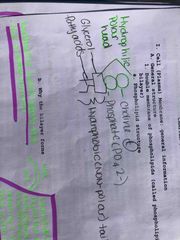
Double membrane of phospholipids called phospholipid by layer |
|
|
|
Cell (plasma) membrane |
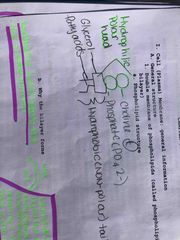
Double membrane of phospholipids called phospholipid by layer |
|
|
|
Cell plasma membrane why the bilayer forms |
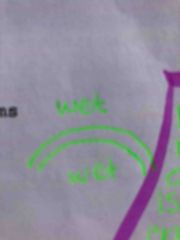
Hydrophilic heads happily face H2L in either direction Hydrophobic tails reject H2O but they’re only stable configuration is to face each other creating a water free zone is the middle |
|
|
|
Fluid Mosaic model selectively permeable |
Consistency of a cell membrane phospholipids aren’t attached to each other they float around Freely consistency like olive oil Are there holes in the membrane (yes and no) Phospholipids can be pushed aside by a small enough molecule creating a temporary hold channel proteins create permanent holes for selected substances |
|
|
|
Facilitated diffusion (to help) |
Passive transport of substances across the cell membrane but to watch the phospholipids in the cell membrane Are impermeable - with the help of transport proteins that grab the substance on one side of the cell membrane and release it on the other side the energy for the transport proteins comes from the kinetic energy In the system (no extra energy needed) |
|
|
|
Solvent what does the dissolving |
Solute is what gets dissolved |
|
|
|
Osmosis |
To understand osmosis you must first know the definition of a solution A mixture no chemical bonds between two substances can be any number of substances in which the solvent (water) is not affected but it basically breaks down the salute (sugar) into its smallest parts (ions Atoms or molecules) which remain suspended and evenly spaced and indefinitely |
|
|
|
Osmosis #2 |
Diffusion of water across a selectively permeable membrane in response to a difference in solute concentration on either side of the membrane The membrane is permeable to water (the solvent) but is impermeable to what is dissolved in the water (the solute) Water moves in response to a difference in the concentration of solute’s (and therefore of water) on either side of the membrane Water moves from the side in which it is more concentrated to the side in which it is less concentrated since the membrane is impermeable to the solute the solute does not move across |
|
|
|
Osmotic pressure |
The ability of a solution to draw water across a selectively permeable membrane from another solution Measured as the pressure of the water flowing across the membrane the greater the difference in the solute concentration on either side of the membrane the higher the osmotic pressure is on that membrane |
|
|
|
Isotonic solutions |
Two or more solutions with the same solute concentrations Red blood cells must be isotonic to blood plasma to maintain a healthy shape |
|
|
|
Hypertonic solutions |
Solution a is hypertonic to solution be if solution A has a higher solute concentration then B If a red blood cell floating in blood plasma or for a plant cell surrounded by some fluid both the cytoplasm of the cell and the surrounding liquid or solutions in the following cases the cell is hypertonic to the surrounding liquid If a red blood cell is hypertonic to the plasma it will swell and burst because being hypertonic to the plasma the red blood cell has a higher concentration of the solute’s and a correspondingly lower concentration of water which results in water diffuses into the cell from the plasma |
|
|
|
Hemolysis |
Bursting of a hypertonic red blood cell (can kill you) |
|
|
|
Lysis |
Bursting of any hypertonic animal cell explode or blow up If a plant cell is hypertonic to the surrounding liquid the cell will swell but it will not burst the cell will gain water and the cell membrane will push up against Reason: the cell wall which is strong enough to contain the liquid without bursting we say the plant cell has increased it turgor pressure or has become more turgid |
|
|
|
What keeps phospholipids from bunching up? |
Cholesterol this is a slippery molecule and it breaks up log jams of phospholipids helps to spread out |
|
|
|
What keeps phospholipids from bunching up #2 (Fluid Mosaic model) |
Crooked tails on phospholipidsThis makes phospholipids asymmetrical which prevents them from packing to densely double bonds make this Bend |
|
|
|
Embedded with proteins with various functions (Fluid Mosaic model) |
Channel proteins This is in bedded in the bilayer and has a hole through it with a specific shape only allowing certain substances to pass permanent hall and membrane which allow certain things to pass through Transport proteins on it’s receiving end if a molecule bangs into it with the proper shape (lock and key model) the Protein closes on the other end Letting the molecules through Hormone receptors The shape of proteins receiving And must match the hormone shape lock and key once the hormone makes contact the protein releases a small molecule which diffuses into the nucleus turns on a gene and initiate a metabolic reaction Cell surface markers (antigens) (flag ) cell adhesion attached to cytoskeleton |
|
|
|
Functions of the cell membrane |
Communication with other cells and self identification cell surface markers a.k.a. antigens mostly made of proteins identify cell as to tissue type in as belonging to a particular individual organelle membranes do not have these These keep the body from having an immune response against itself (roving antibodies and tissues check out a cells cells surface markers and attack it if the wrong Type) |
|
|
|
Functions of the cell membrane #2 |
Receptors and cell membrane Also made of proteins receive hormones are (chemical messengers) from other cells which tell this cell what to do (such as speed up Metabolism) Cell membranes give the cell shape and protection Cell membranes are selectively permeable Phospholipids are permeable to substances soluble In lipids (example substances without a charge like steroids vitamins A D E K) Small molecules CO2 O2 and H2O with little or no charge |
|
|
|
Functions of the cell membrane #3 |
Phospholipids are impermeable to large molecules (proteins) & carbohydrates and charged particles (ions) Protein channels and transporters both are proteins that span the cell membrane both carry substances across the membrane that phospholipids are in permeable to both are highly selective about what they will let |
|
|
|
Passive movement |
Relies on kinetic energy already in the system kinetic energy is energy that causes matter to move like body heat (riding a bike down a hill) BrownianMovement Heat causes particles to randomly shake and collide with each other diffuse the collisions caused the particles to spread out |
|
|
|
Active movement like riding a bike up a hill |
Additional energy (besides the kinetic energy in the system) is required to move the particles across the cell membrane the energy comes directly from ATP (ultimately from glucose or other food sources converted into glucose) ATP Gives energy to other molecules to get work done |
|
|
|
Passive movement simple diffusion |
Spreading of particles from areas of high concentration to areas of low concentration as they defuse the particles move down there concentration gradient diffusion occurs with or without a membrane it will only occur across a membrane that is permeable to the diffusing substance Particles continue to diffuse across a membrane until both sides of the membrane or in equilibrium particle -concentrations are equal on both sides |
|
|
|
Hypotonic solutions |
Solution a is hypotonic to solution be if solution A has a lower solute concentration then B Note again both the cell and the surrounding liquid are solutions in this case the cell is hypotonic to it surroundings If a red blood cell is hypo tonic to plasma it will lose water and shrink Reason: Being hypotonic to the plasma the red blood cell has a lower concentration of solute’s and a correspondingly higher concentration of water result: water diffuses out of the cell and into the plasma |
|
|
|
Plasmolysis Hypotonic solutions |
If a plant so is hypotonic to it surroundings the plant will lose water the cell membrane shrinks in from the cell wall which keeps its shape Called plasmolysis we say the cell has lost its turgor pressure or has become flaccid (on the tissue level this is equivalent to a leaf wilting) |
|
|
|
Active movement active transport |
(Heat energy is not enough) works just like facilitated diffusion (transport proteins carry impermeable substances across the cell membrane) but the substances Cross the membrane against their concentration gradients example From low to high concentration (needs a push) from ATP requires energy from ATP (40% of a cells ATP goes to active transport) ATP is energizing proteins by pumping out of cell |
|
|
|
Difference between the two processes |
Facilitated difference is pass it only requires heat energy active transport move substances move from high to low concentration ATP is energizing proteins by pumping out of cell |
|
|
|
Bulk transport |
Bulk transport across the cell membrane movement of large molecules are particles in either direction across the membrane Note: because the cell membrane is changing shape this requires extra energy from ATP in there for qualifies as active movement |
|
|
|
Endocytosis |
Engulfment of large molecules or particles by a cell membrane changing shape to surround them |
|
|
|
Phagocytosis |
Engulfment of large particles (can be a smaller cell) pseudopods (false feet) or formed to engulf the object amoebas feed this way , some white blood cells do it to bacteria and cancer cells |
|
|
|
Pinocytosis (take in) |
Engulfment of droplets of extracellular fluid containing various large molecules Call cell drinking No pseudopods formed Happens in cells of placenta embryo drinks in mothers fluids |
|
|
|
Receptor mediated endocytosis |
Exactly like Pinot cytosis which is non-specific as to what it absorbs except here receptors in “coated pits “ bind with specific molecules dissolved in the solution outside of the cell Drops of the solution are then engulfed |
|
|
|
Exocytosis (exit) Pinocytosis in reverse |
Opposite of endocytosis substances are brought out of the cell happens when things like hormones enzymes or mucus are secreted from a cell Exocytosis releases droplets of liquid on a cellular level the same processes |
|
|
|
Tight junctions Cell junctions |
Random patterns of short rivet like proteins press two membranes tightly together result slows diffusion between cells found where cells of different tissues meet so they don’t mix their contents |
|
|
|
Gap junctions opposite Cell junctions |
Channel proteins line up between two membranes creating holes between cells result speeds up diffusion between cells found between Hartsell’s so ions shoot across and cause cells to contract simultaneously |
|
|
|
Plasmodesmata Cell junctions |
Gap junction between plant cells: piece 2 cell membranes and 2 cell walls useful in transporting H2O and SAP up and down the plant |
|
|
|
Cell junctions desmosomes |
Strongest junction of all four kinds Rod like proteins peace through the cells to be joined found in areas of great where in tear like between muscle cells |
|

